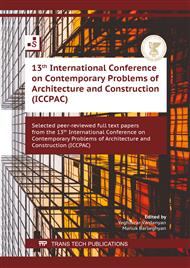p.43
p.51
p.59
p.65
p.73
p.79
p.85
p.95
p.115
Identification of Effective Solutions to Replenish the Housing Stock in Armenia and Artsakh
Abstract:
About 90% of the apartment buildings that constitute Armenia's housing stock were built before 1990. After the devastating 1988 Spitak earthquake, the seismic conditions in the country were revised and these buildings no longer meet current seismic standards. About half of Armenia's population lives in these buildings, so the reliability, cost-effectiveness and durability of these structures are extremely important for the country. In addition, a number of other causes contribute to the deterioration of the technical condition of the housing fund over time: exogenous geological phenomena, physical and mechanical properties of the soil, the service life of the housing fund, non-compliance with operating conditions, bombardment, etc. The houses built in the Republic of Artsakh are relatively new, but during the September 27, 2020 war unleashed by Azerbaijan, more than a thousand houses were bombarded. They are no longer suitable for use. Following from the above, it is worth to note that in Armenia, as well as in Artsakh, there is a great demand for the reconstruction of the housing stock. In recent years, mainly monolithic, sometimes stone buildings have been constructed in Armenia and Artsakh. Large-panel buildings are almost completely excluded from construction projects. The reason for this is the low energy efficiency of these buildings. However, there are now new high-performance thermal insulation materials that can easily solve this problem. The purpose of the article is to show the feasibility and advantages of constructing large-panel buildings as an effective way to replenish the housing stock in Artsakh and Armenia.
Info:
Periodical:
Pages:
73-78
Citation:
Online since:
February 2022
Authors:
Price:
Сopyright:
© 2022 Trans Tech Publications Ltd. All Rights Reserved
Share:
Citation:


